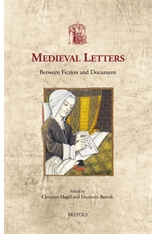Medieval Letters Between Fiction and Document, ed. Christian Høgel and Elisabetta Bartoli, with a preface by Francesco Stella and Lars Boje Mortensen (Turnhout, 2015: USML 33), x+471 pp. ISBN 978-2-503-55520-1.
Modern scholarship on medieval letters has often focused on the divide between fictionality and historicity. Attempts have been made to distinguish between ‘real’ letters and those that were used as stylistic models, and discussion has focused on how to make use of these texts as historical sources. In this volume, which draws on the proceedings of the ‘Medieval Letters between Fiction and Document’ conference held in Siena in 2013, scholars including Peter Dronke, Ronald Witt, Joan Ferrante, and Sylvie Lefèvre analyse the historical value of medieval letters in both Latin and other European languages and explore different disciplinary approaches to the field. Comprising contributions on methodology, Latin literature up to the fifteenth century, Byzantine and Romance literature, and courtly letters, this unique book also documents the debate on unedited texts — including women’s love letters — and on celebrated cases of disputed authorship such as the Epistolae duorum amantium and Dante’s Epistola to Cangrande. It thus offers a significant re-evaluation of the huge and partly unpublished heritage of medieval letters across Europe, and provides important insights into the use of these unique sources in social, literary, and legal history.
Contents:
Francesco Stella and Lars Boje Moretnsen, “Preface”
Part I: Methods
Wim Verbaal, “Epistolary Voices and the Fiction of History”
Walter Ysebaert, “Medieval Letters and Letter Collections as Historical Sources: Methodological Questions, Reflections, and Research Perspectives (Sixth-Fifteenth Centuries)”
Paolo Cammarosano, “Lettere fittizie e lettere autentiche nel medioevo italiano (secoli XII-XIV)”
Part II: Before ars dictaminis: The Early Middle Ages
Francesco Mosetti Casaretto, “La lettera di Ermenrico tra finzione e realtà”
Carlos Pérez González, “Un precedente del ars dictaminis medieval: las epistolae de Eginardo”
Part III: The Eleventh and Twelfth Centuries: Ars Dictaminis and the ‘epistolary turn’
Florian Hartmann, “Il valore sociale dell’ars dictaminis e il self-fashioning dei dettatori communali”
Elisabetta Bartoli, “Da Maestro Guido a Guido Faba: autobiografismo e lettera d’amore tra la seconda e la terza generazione di dettatori”
Vito Sivo, “Il Registrum di Paolo Camaldolese: elementi contenutistici e stilistici”
Greti Dinkova-Bruun, “Aegidius of Paris and His Two Letters to Bishop Odo”
Roberto Angelini, “Powerful Women in the Epistles of Hildebert of Lavardin”
Part IV: Women and Love Letters
Joan M. Ferrante, “What Really Matters in Medieval Women’s Correspondence”
Paolo Garbini, “Il pubblico della Rota Veneris di Boncompagno di Signa”
Peter Dronke, “Women’s Love Letters from Tegernsee”
Marek Thue Kretschmer, “The Play of Ambiguity in the Medieval Latin Love Letters of the Ovidian Age (Baudri of Bourgeuil and Gerald of Wales)”
Francesca Battista, “Queen Kunhuta’s Epistles to Her Husband”
C. Stephen Jaeger, “Irony and Subtext in Latin Letters of the Eleventh and Twelfth Century”
Part V: Documents, Literary Letters and Collections in Byzantium and Beyond
Michael Grünbart, “From Letter to Literature: A Byzantine Story of Transformation”
Christian Høgel, “The Actual Words of Theodore Graptos: A Byzantine Saint’s Letter as Inserted Document”
Divna Manolova, “‘If It Looks Like a Letter, Reads Like a Letter, and Talks Like a Letter’: The case of Nikephoros Gregoras’ Letter Collection”
Sylvie Lefèvre, “La lettre et ses addresses”
Part VI: The Thirteenth and Fourteenth Centuries and The Diffusion of Epistolary Rhetoric
Ronald Witt, “Ars Dictaminis: Victim of Ars Notarie?”
Thomas Ricklin, “Indagine su un disguido epistolare: l’Epistola a Cangrande fra Verona e Padova”
Alberto Casadei, “Essential Issues Concerning the Epistle to Cangrande”
Fulvio Delle Donne, Dalle lettere cancelleresche ai dictamina: processi di finzionalizzazione e tradizione testuale”
Benoît Grévin, “From Letters to Dictamina and Back: Recycling Texts and Textual Collections in Late Medieval Europe (Thirteenth-Fourteenth Centuries)”
Julia Bolton Holloway, “Brown Ink, Red Blood: The Plotting of the Sicilian Vespers”
Part VII: Late Medieval Court Letters
Monica Ferrari and Federico Piseri, “Tra resoconto della quotidianità e progetto di futuro: la lettera come strumento pedagogico nella corte sforzesca della seconda metà del Quattrocento”
Maria A. Soleti, “Christine de Pizan in Correspondence: The Epistolary Exchange Waxes Poetic with Eustache Deschamps”
Sacramento Roselló-Martínez, “Memorial de Agravios: Letters of Grievances as Documents in Fifteenth-Century Castilian Historiography”


